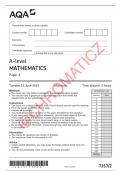Samenvatting
Summary Biological Psychology (James W. Kalat) book notes according to reading list
- Vak
- Instelling
- Boek
These are ALL the bold terms + explanations from the Biological Psychology book by James W. Kalat, according to the reading list from the course Biopsychology and Neuropsychology ( as of 2020/2021), so chapter 1-4, 7, 8, 11-14.
[Meer zien]













